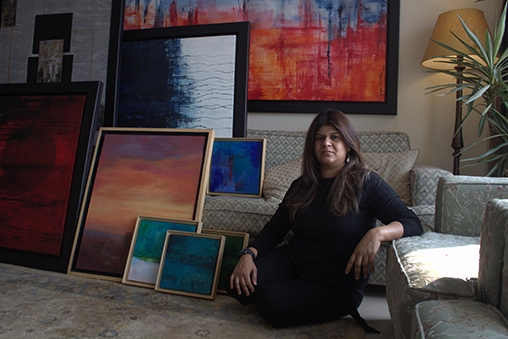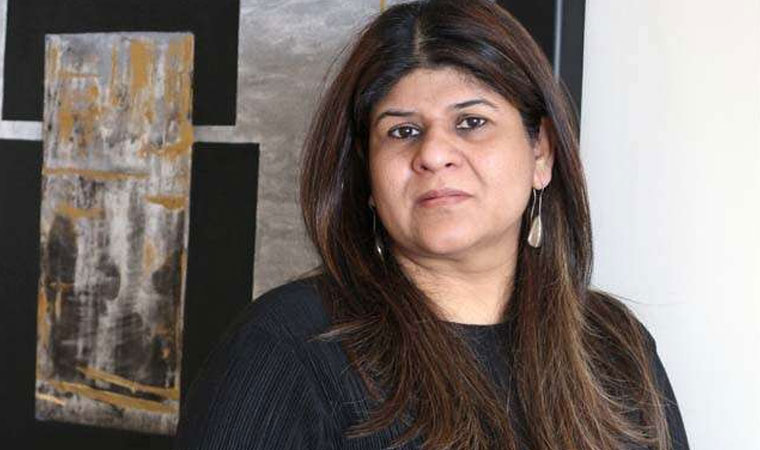Artist Gunjan Shrivastava’s New Work Aims To Enable Women To Accept Scars
A trained contemporary visual artist, Dr Gunjan Shrivastava has been exploring different art mediums and inspirations through her journey as an artist for 20 years. Her last solo show at Jehangir Art Gallery in Mumbai was on the theme of five elements of nature. She has unveiled her latest collection, The Victory Chronicles – Tales of the positive triumphal woman ahead of International Women’s Day, and is available for viewing at here.
Celebrating the positive triumphal woman, Dr Shrivastava offers this series as a collection of artworks that have been exclusively curated and captures the spirit of the woman who has accepted herself, all her wounds, scars, bad days, good days, failures, triumphs and come out shining like a star. She believes that her scars are a mark of new birth within herself, and a milestone in her journey of life. Not limited to any one style or medium of work, her works range from generic mediums such as oil or acrylic on canvas to more complex and experimental works on mixed media and cyanotypes.

The professional artist, who is also an educator, art critic and Co-founder of You Lead India Foundation says, “Every woman has scars, some visible, some invisible. It is how we accept these as a part of our journeys that defines who we are. Hence, there was no better occasion than International Women’s Day to spread this message. As women, we need to come together to support, and lift our fellow sisters, and create awareness that having a scar is not the end of the journey, but a bend in the road, or the start of something new. My new collection marries these ideas, with my passion for slow art. My works focus more on the experience than the outcome.”
In a freewheeling chat, the artist talks more on her experiences, sensibilities and perspective of life.
Over the years, art as a field has come up in people’s perceptions. How have you experienced this change?
The art world has evidently changed substantially over the years. It is an expanding field that has become increasingly professional and also commercial. The 20th century gave birth to a multitude of experiments, new conceptual styles, and unseen use of materials. With the proliferation of museums, biennales and fairs, and the amount of work now being made, shown, and sold has made it a challenging space. These changes have been a part of my journey in all these years as an artist, I have embraced the change and grown around new concepts, learning from each and everybody in this domain.

Did you face any social or family resistance when you took up this field?
It was a reverse situation in my life, I was always encouraged by my parents to take up art as my career. More so, as my mother has been in the creative field as a trained musician for years, she always inspired me. Even later in life, I am blessed to have a life partner who understands me and supports my choices in life.
How has this profession rewarded you personally? Can you share an instance of joy or satisfaction?
The biggest reward of being an artist is to be able to communicate with people. For me, art is a process based on dialogue and that conversation through my art is the deepest part of my inspiration. The appreciation and encouragement I receive from my viewers is always very gratifying. Talking about an instance, it was truly rewarding when my works in cyanotype was appreciated and honoured by the Governor of West Bengal.
What is the best and the worst thing about being an artist?
Being an artist lends me that freedom to do what I love doing most. There is nothing that I do not enjoy being an artist, but the only disadvantage about being an artist is that one does not know when to stop being an artist. It is not like any other 9 to 5 job, once an artist always an artist. Your eyes are always in critique mode and seeking visual interests around you.

How do you decide upon the different themes for your shows?
I enjoy working intuitively, which gives me the liberty to change my subject. But nature is something that is evidently present in my works, also because it is something fundamental in our lives. Inspired from the vibrant world around me, I create works around the organic and natural forms of nature. My body of works form their own narrative and flow to create a theme on their own.
How has the pandemic inspired artists differently? With everything going digital during this period, has the pandemic opened up more digital platforms for artists?
This pandemic gave birth to countless and wonderful artworks. Art has an unspoken power, an energy of creation that will never exhaust and we witnessed creativity at its peak in these unpredictable times. Every artist had its own share of experience which they tried to portray through their art. Though this pandemic has undeniably seen a change in artistic trends and possibly altered the landscape of the industry. With many large events cancelled or postponed, a few moved to virtual. This innovative trend or rather the shift towards online exhibition is a new experience for artists, but definitely it has opened up a new way of projecting art. It has taught us a novel way of viewing art especially benefitting artists who found it a challenge to find space or means to exhibit in galleries.

As the world struggles to get back to its feet, art galleries are also trying to reinvent themselves in these times of uncertainty. The last few months have shown a huge potential of online art. Though, world will gradually surface back to on-site exhibits but still this trend is going to stay.
You are an art educator and mentor as well. What aspects do you need to think twice about when you are a mentor for an upcoming artist?
As an artist and educator for 20 years, I understand what takes to create and the challenges that come with it. As a mentor in this field, I use my experience and expertise to help upcoming artist with practical guidance and support they need. Though, some of my experiences might not be agreeable but I make sure to endorse positivity to motivate artists towards inspired action.
What do you think needs to be done in society for the field of art to get its due?
Art needs appreciation and acceptance in whatever form it is presented. Art and society are interdependent, as they both need each other. Sometimes art is used for recreational purpose and sometimes for awareness, but for whatever reason, art thrives on
What is your advice to young art students and aspirants today?
Be authentic and spend time exploring yourself and what are you drawn towards. Do not limit yourself, you never know what might work for you. Explore, be open to exploring new techniques, experiment with unknown mediums. Don’t be worried about failing, take every failure as a lesson and trust yourself. Lastly, enjoy your process of art making, don’t always look for a final piece. Your best artworks will always have a story of their own.


Leave a Reply